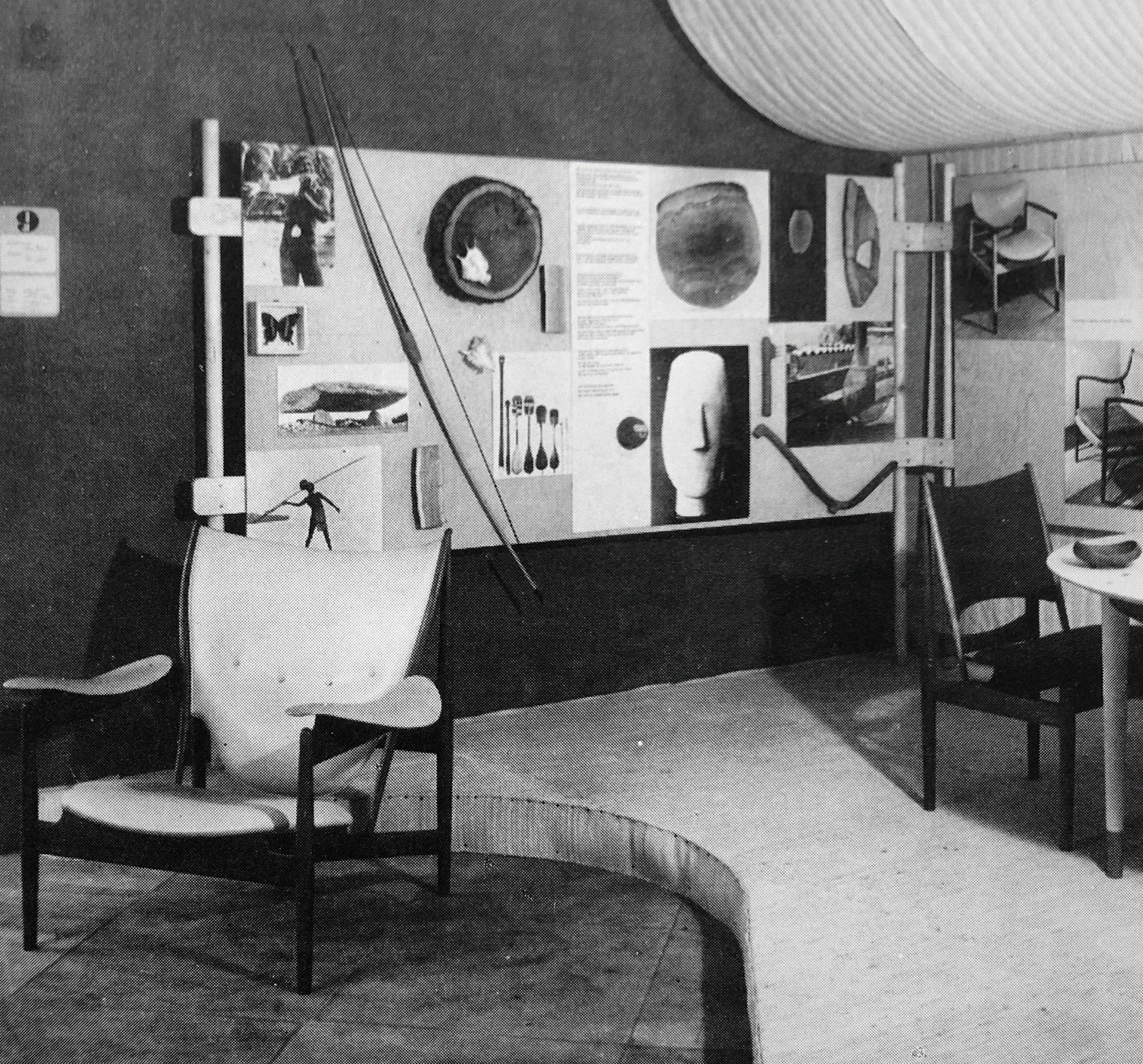Finn Juhl
FINN JUHL (1912-1989)
Finn Juhl is considered to be the most influential Danish Modern furniture designer. His crowning achievement is the Chieftain Chair, the largest and most daring design of his career. First presented at the Cabinetmaker’s Guild Exhibition in Copenhagen in 1949, the chair was unprecedented, and it stole the show. At the unveiling, King Frederick IX sat in the chair, causing a journalist to suggest calling it the “King’s Chair”. But Juhl didn’t like how pretentious that sounded and quickly said, “You had better call it a chieftain’s chair,” and the name stuck.
The Chieftain Chair is considered to be a seminal work in the golden age of Danish Modern design.
Photo: 1949 Cabinetmaker’s Guild Exhibition
ORIGINS
Finn Juhl described himself as a self-taught furniture designer, and his approach was free of conventional restrictions or preconceptions. In the 1930s his work was heavily influenced by sculpture and organic forms, and it was considered radical at a time when other furniture designers adhered to the rigid (often austere) linear functionalism prescribed by Kaare Klint who established the Department of Furniture Design at the Royal Danish Academy of Fine Arts.
Photo: Finn Juhl approached his work more as an artist than a designer.
In the 1940s, Juhl departed from his heavily upholstered sculptural forms and began to experiment more with the shaping of wood. As an artist, he approached his work as a sculptor trying to bring his materials to life. In his best work it is difficult to discern where one piece of wood ends and another begins. This was something that the furniture industry had never seen before, and it became a very influential style. It was during this period that cabinetmaker Niels Vodder became an essential part of Juhl’s success. Vodder’s unparalleled joinery skills enabled Finn Juhl to push the limits of the wood, finding the perfect balance between stability and delicate sculptural form.
Also unique to his work was his desire to separate the furniture into two elements: The supporting and the supported. He strove to make a visual disconnection between the structurally supportive elements of the furniture and the surfaces that carried the sitter. The intention was to make a person appear to float above a chair’s frame. The Chieftain Chair was one of the first designs to employ this ethos.
“Art has always been my main source of inspiration. I am fascinated by shapes which defy gravity and create visual lightness.” – Finn Juhl
THE CHIEFTAIN
In the late 1940s, Finn Juhl visited the Musée du Louvre in Paris where is saw a very beautifully preserved 3500 year old chair from Ancient Egypt. He was very interested in the composition with particular emphasis on the triangular backrest support. In addition to the Egyptian chair, he also himself drawn to tribal art and weaponry. The combination of these thematic areas of interest led to two of his most celebrated designs; the Egyptian Chair and the Chieftain Chair.
Photo: The ancient Egyptian chair clearly influenced Juhl’s design. Most notably we can see a similar triangular framing of the backrest and the horn on the top of the chair.
The Chieftain chair was composed of shell-like pieces suspended on a delicate looking frame of teak. The arms and backrest looked to have been directly influenced by a tribal shield. Shields were often made from stretched pieces of cowhide cut into elongated forms. The vertical stiles that support the backrest are reminiscent of weaponry such as the bow shown directly behind the chair in the Guild Exhibition in 1949.
Photo: 1949 Cabinetmaker’s Guild Exhibition. Finn Juhl’s display shows a collage of tribal influences on the surrounding walls.
“I started drawing the Chieftain Chair one day in the spring of 1949. I was at home, and I started drawing a small sketch around 10 AM with just four vertical lines connected with something. By two or three o’clock in the morning I had painted it. But in reality, I don’t know how long it took me to design that chair. Perhaps I had a vague idea for some time that I wanted to design something bigger. There had been so many small, handy chairs, so I probably felt like designing something a bit more pompous…”
When presented at the 1949 Cabinetmakers Guild Exhibition, it was described as such:
“The Chieftain Chair, designed according to the scientific principles ensuring maximum comfort is already designated winner of this edition… This chair is so lively that it seems trembling with vitality… Finn Juhl conclusively has his place amongst great artists”.
It should be noted that in 1948, Finn Juhl presented at the Guild Exhibit in Copenhagen that can only be described as the predecessor for the Chieftain chair. The chair is far less elegant than the Chieftain presented the following year, but we can see that some of the fundamental characteristics emerging. Most notably, the horns of the chair, oversized arms, and large buttoned backrest. The chair was enthusiastically received by the public, and as one reviewer wrote, 'He has designed some nice upholstered armchairs with asymmetrical arm rests. The one on the right, which is the widest, has a built-in circular brass tray which can serve as an ashtray as well as providing a place to put one's whisky glass!’.








